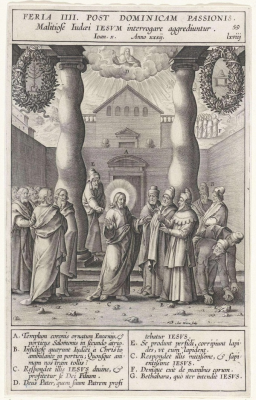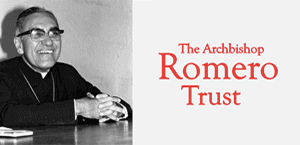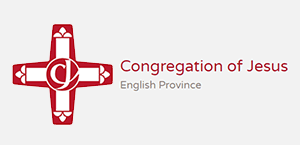Gospel in Art: Jesus was walking in the Temple, in the colonnade of Solomon

Christ in the temple of Jerusalem, portico of Solomon, conceived by Fr Jerome Nadal and Bernardino Passeri, Engraving by Hieronymus Wierix, 1593, Antwerp. From Evangelicae Historiae Imagines
Source: Christian Art
Gospel of 13 May 2025
John 10:22-30
At that time the Feast of Dedication took place at Jerusalem. It was winter, and Jesus was walking in the Temple, in the colonnade of Solomon. So the Jews gathered around him and said to him, 'How long will you keep us in suspense? If you are the Christ, tell us plainly.' Jesus answered them, 'I told you, and you do not believe. The works that I do in my Father's name bear witness about me, but you do not believe because you are not among my sheep. My sheep hear my voice, and I know them, and they follow me. I give them eternal life, and they will never perish, and no one will snatch them out of my hand. My Father, who has given them to me, is greater than all, and no one is able to snatch them out of the Father's hand. I and the Father are one.'
Reflection on the Engraving
Saint Ignatius of Loyola (1491-1556), founder of the Jesuit Order, commissioned Father Jerome Nadal (1507-1580) to produce an illustrated Bible to help people engage more deeply with Scripture. Deeply aware of the power of visual learning in a largely illiterate society, Ignatius commissioned his close companion, Father Jerome Nadal (1507-1580), to create a series of illustrated biblical scenes to aid meditation and prayer. This project resulted in the Evangelicae Historiae Imagines (Images of Gospel History), first published posthumously in 1593. Rather than a conventional illustrated Bible, it was a collection of 153 detailed engravings depicting key moments from the Gospels, each carefully annotated to guide contemplation in line with Ignatian spirituality. Nadal's work reflected the Jesuit mission to use every means, education, art, and preaching, to draw souls closer to Christ. These images were not merely decorative but served as tools for "composition of place", a core element in Ignatian meditation, helping the faithful to imaginatively enter into Gospel scenes. The Evangelicae Historiae Imagines became a cornerstone of Jesuit pedagogy and pastoral outreach, blending Renaissance artistry with the dynamic spirituality of a rapidly growing religious order dedicated to "finding God in all things." Our illustration is one of these 153 engravings.
Our illustration is carefully annotated with numbers and letters to guide the viewer through the scene. The number 59 in the top right corner tells us this is the 59th event from Jesus' life depicted in the series. Below that, the Roman numerals indicate where this Gospel passage falls within the liturgical calendar of the time, according to the Roman Missal. The title at the top, 'Feria IIII post Dominicam Passionis', places us in the Fourth Week after Easter. The letters within the image act as a key: 'A' points to the Portico of Solomon, where today's Gospel scene unfolds; 'B' highlights the group of Jewish leaders questioning Jesus with the words, 'If you are the Christ, tell us plainly'; and 'E' shows two men preparing to stone Him, reflecting the growing hostility He faced.
Our Gospel reading tells us that "Jesus was walking in the Temple, in the colonnade of Solomon". In art history, Solomonic columns refer to columns that have a distinctive spiral or twisted shape, resembling a corkscrew. The term comes from the belief that such columns were originally part of the Temple of Solomon in Jerusalem. According to tradition, when Constantine built the original Old Saint Peter's Basilica in the 4th century, he brought back columns from Jerusalem, believed to be from Solomon's Temple, and placed them around the high altar. These ancient columns were twisted in form, and so the style became known as "Solomonic." While the historical accuracy of their origin is debated, the association remained strong throughout Christian art and architecture.
When Gian Lorenzo Bernini designed the magnificent baldachin (canopy) over the high altar in the new St Peter's Basilica in the 17th century, he deliberately chose the spiral Solomonic column design to echo this ancient tradition, also in reference to today's Gospel reading. Bernini's decision was not merely aesthetic; it was rich in symbolism. The twisted columns linked the new basilica to the legacy of both Solomon's Temple and Constantine's first church on the site, creating a visual and theological continuity. The spirals also suggest upward movement, drawing the eye (and therefore the soul) towards heaven. Furthermore, the dynamic, flowing form of the columns embodied the spirit of the Baroque, with its emphasis on movement, drama, and the blending of heaven and earth.
LINKS
Gospel in Art: https://christian.art/
Today's Reflection: https://christian.art/daily-gospel-reading/john-10-22-30-2025/ (with audio)


















